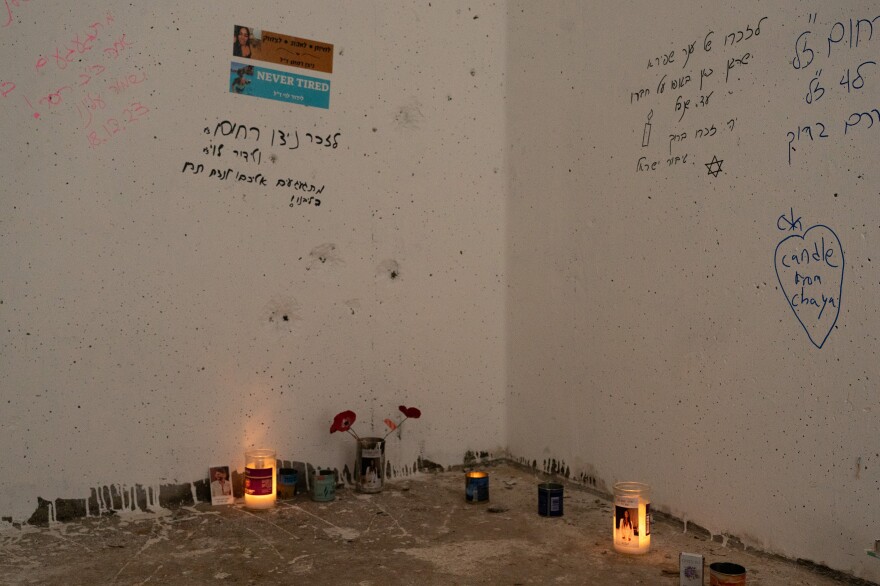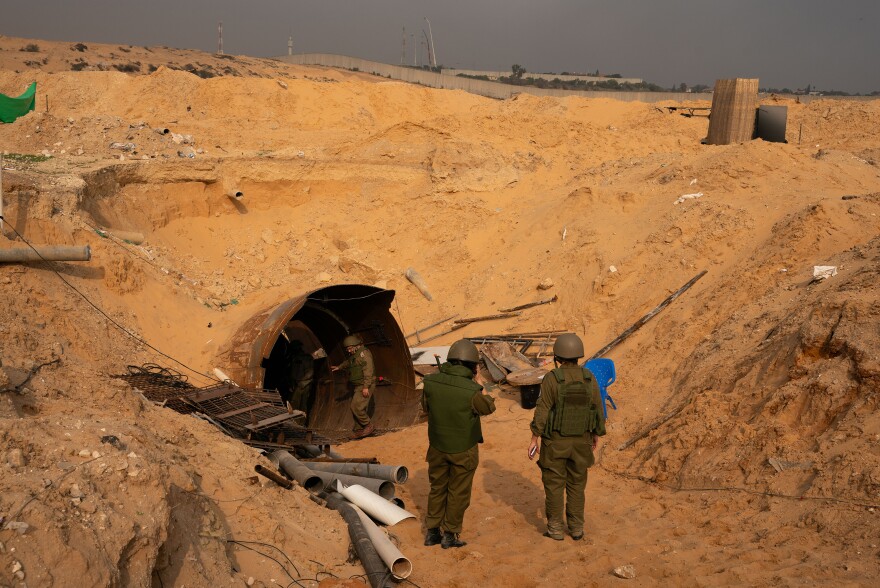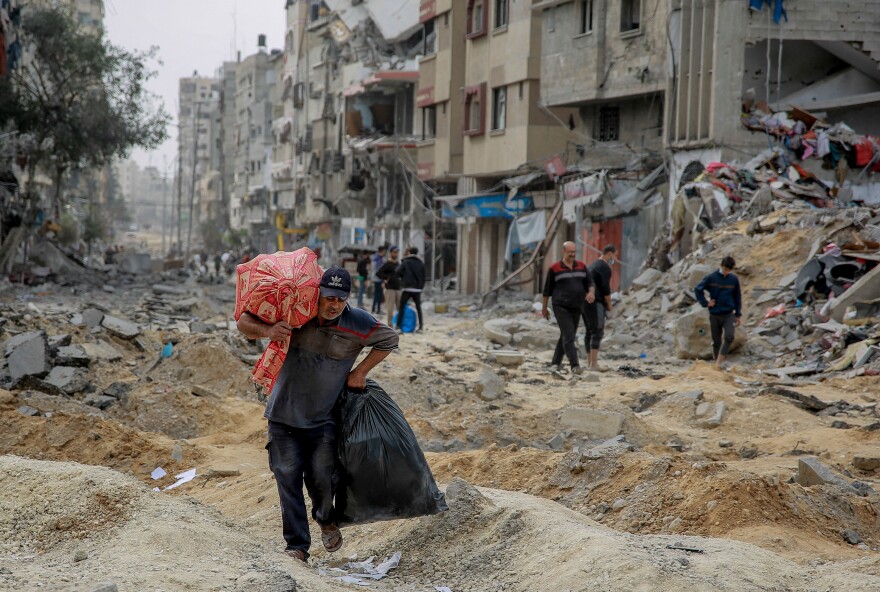TEL AVIV, Israel — In the 100 days since Oct. 7, the day that fighters from the militant group Hamas burst across Israel's southern border, Israeli officials have vowed not to stop fighting until Hamas has been destroyed.
The attackers killed 1,200 people and took about 240 individuals hostage, according to Israel — shaking the country's sense of security to its core. Israel's military response, with an air, ground and sea assault on Gaza, has killed more than 23,900 Palestinians, health officials in Gaza say, and has left much of the territory in ruins.

In more than three months of war, there are some signs that Israel has made progress toward reaching its stated goals. Its military says it has killed Hamas officials and thousands of fighters. It has seized and destroyed Hamas military infrastructure, including rocket launchers, operations centers and a lot of its underground tunnel network.
But on other counts, military analysts say, Israel has failed to accomplish what it set out to do. It has not yet captured or killed Hamas leaders like Yahya Sinwar, the group's top official in Gaza. It has been unable to secure the release of more than 100 hostages still alive in captivity. And the civilian death toll in Gaza has brought Israel broad international criticism and pressure, including from the Biden administration.
Analysts warn that the war could get even more dangerous for the people of Gaza, even as concerns grow about risks that the war could spill over into a wider regional conflict with other countries.
Without a clear exit strategy, Israel's "broader strategic goal" — the eradication of Hamas — may be impossible to achieve, said Dan Byman, a senior fellow at the Center for Strategic and International Studies.
Its success "will depend in part on destroying Hamas' military force, but also in part on ensuring that whatever [leadership in Gaza] comes in next has some legitimacy, has some ability to function," he said.
Israel has set out to dismantle Hamas' military infrastructure
A lot of Israel's military attention and public comments have focused on the vast network of tunnels snaking under Gaza that Israeli military officials have dubbed "the Metro."
Israel estimates the passageways and shafts run as many as 300 miles through the enclave. Since Israeli ground troops secured the area around Erez, the border crossing from north Gaza into Israel, military officials have frequently shown off their biggest "Metro" trophy, claiming it to be the largest and most complex tunnel Hamas built.

On a day in late December, Israeli military spokesperson Maj. Doron Spielman led a dozen journalists through a section of what was once the concrete barrier that separated Israel and Gaza. It was blown out by Hamas fighters on Oct. 7, making it possible to step directly onto Gaza's sandy soil, as drones buzzed overhead.
What seemed to be a rusty drainage pipe jutting out of a sand dune was, in fact, the opening of Hamas' largest "single subway tunnel," Spielman said.
Just a few hundred feet from the border crossing, an initial steep climb down rickety metal grates led to a large concrete tunnel, complete with wiring and ventilation, that snaked past two armed soldiers and disappeared into the dark.
The tunnel, nearly 2 1/2 miles long, was lined with shafts leading even farther underground to command centers, where fighters from Hamas were "storing weapons, going through maps and planning their attacks," Spielman said.
Military officials say they found a video showing Muhammad Sinwar, brother of top Hamas leader Yahya Sinwar, driving a car through the tunnel. Spielman says cars drove all the way to and from Gaza City.

In total, Israel says there are hundreds of miles of tunnels throughout Gaza, including underneath sensitive civilian infrastructure like hospitals and refugee camps. "Hamas has persistently and deliberately invested enormous amounts of money and resources into terrorist tunnels that serve only one purpose: attacking the state of Israel and its residents," said Lt. Col. Richard Hecht, another military spokesperson, in December. "For Hamas, attacking the people of Israel continues to take priority over supporting the people of Gaza."
Israel's effort to dismantle Hamas' tunnel network and other military infrastructure has relied on airstrikes that have killed and injured civilians and have left Gaza City in ruins. Palestinian officials say some 70% of the dead are women and children.
When asked about the high death toll from Israeli airstrikes, Spielman said the only way to dismantle and clean out the tunnels is for the air campaigns to make it safe for Israeli soldiers on the ground.
"We would love to have a better way. I know we don't want to kill civilians, and they are a very unfortunate consequence of Hamas having spent so many years building under their feet," he said. "If anyone has a better idea, I think we would love to hear it."

Palestinians living in Gaza say Israel's campaign has disproportionately harmed civilians.
"Go underground and fight Hamas," said Mohammad Hamdan, 30, as he cleaned up rubble after an Israeli airstrike that leveled his neighbor's home and left several dead. "We are not Hamas. They are not dying. The people are."
Mixed military results
There have been growing international calls for a cease-fire, and the Biden administration has urged Israel to curtail the intensity of the operations in Gaza. But Israel's leaders have vowed to push on, insisting a military victory can be achieved.
Evidence of that so far is mixed, military analysts told NPR.
Byman, of the Center for Strategic and International Studies, said he believes Israel is winning the war, but adds many caveats.
Though it has destroyed many Hamas tunnels, Israel has also discovered how much the underground network has grown since Israel withdrew from its occupation of Gaza nearly 20 years ago, he said.
Israel also claims to have killed many top Hamas commanders and as many as 8,000 Hamas fighters. Officials in Gaza do not distinguish between combatant and civilian casualties when reporting death tolls.

Israeli forces have also taken losses. Since the start of their ground operation in Gaza in October, at least 186 soldiers have been killed and 1,085 injured, according to the Israeli military.
"Hamas continues to retain the majority of its fighters. It continues to retain a significant military capacity. But after several months of fighting, Israel has made a dent in it," Byman said.
But Byman also warned caution about Israel's claims, including how it defines combatants. "When Israeli forces go into a neighborhood, do young men of fighting age pick up weapons? And does that count as a Hamas fighter or not?" Byman said.
Estimates of Hamas troop levels before the war range from 15,000 to as high as 40,000 fighters, analysts told NPR. If Israel's death toll for Hamas fighters is to be believed, anywhere from half to 80% of Hamas' forces could remain on the ground, said Samir Ghattas of the Middle East Forum for Strategic Studies and National Security in Cairo.
But such estimates and death tolls cannot be relied upon, he added. "We can say that the statements from both sides have been exaggerated," Ghattas said.
Israel was able to quickly assert military control over northern Gaza and rocket fire from Gaza has slowed dramatically in recent weeks, he noted.
Ghattas estimated that although the Hamas artillery and ammunition stockpiles may be running low, they are still plentiful, "with military capability to fight for one or two more months, well into February."
Future fighting will be tougher
What is left of Israel's goals may be tougher to accomplish — and more destructive for Palestinians in Gaza, analysts say.
Israeli officials say they have now entered a new phase of the war, withdrawing some troops from northern Gaza. The battleground has shifted to cities in the south, which were already teeming with displaced Palestinians, forced from their homes by Israel.
More than a million Palestinians are now living in the southern city of Rafah, after Israel pushed residents out of the north. Before the war, Rafah was home to about 275,000 people.
As Gaza's residents pack into ever more crowded areas, Hamas fighters could embed more deeply into the population, said Ahron Bregman, who teaches at the Department of War Studies at King's College London. Ultimately, militants could break up into smaller insurgent groups that would be harder for Israel to hunt and kill, he said.

"They are better trained, the Israelis, in fighting regular armies than fighting insurgencies. And they will find it very difficult, the Israelis, if they do stay in the Gaza Strip, to do counterinsurgency," he said.
Israeli officials have repeatedly promised to "dismantle" Hamas. But rooting out the last of the militant group will be difficult, if not impossible, said James Rands, a military analyst with Janes, a defense intelligence company.
"The problem is that there are 2.2 million civilians in the Gaza Strip and you can't just keep moving them around indefinitely, so that final blow against Hamas to destroy them probably isn't going to be feasible," he said.
The only way to end an insurgency is to offer people hope for a better future, Rands said.
A long-term Israeli occupation of Gaza is widely opposed by U.S. and Israeli officials as well as Palestinians in Gaza, many of whom can no longer envision peaceful coexistence with Israel after more than three months of airstrikes.
Israel's military leaders have signaled they expect to remain fighting in Gaza through 2024. But their effort to end Hamas' rule in Gaza must come with a plan for what comes next, said Byman.
"The political side can't be separated from the military, and in my view Israel has focused much less on the political side than the military side," he said.
Copyright 2024 NPR. To see more, visit https://www.npr.org.









